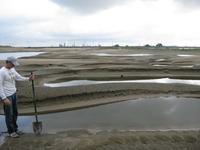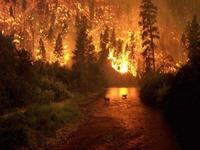-
Odds of storm waters overflowing Manhattan seawall up 20-fold, new study says

Maximum water levels in New York harbor during major storms have risen by nearly two and a half feet since the mid-1800s, making the chances of water overtopping the Manhattan seawall now at least twenty times greater than they were 170 years ago, according to a new study. Whereas sea-level rise, which is occurring globally, has raised water levels along New York harbor by nearly a foot and a half since the mid-nineteenth century, the research shows that the maximum height of the city’s “once-in-10-years” storm tide has grown additionally by almost a foot in that same period.
-
-
Room-scouting robot to help first responders, soldiers

Firefighters, police officers, and military personnel are often required to enter rooms with little information about what dangers might lie behind the door. A group of engineering students at Arizona State University is working on a project which would help alleviate that uncertainty. The product they are building consists of a laser sensor attached to a motor that sweeps all the way around a room, taking 700-800 individual scans, each one with about 680 unique data points. This information is transmitted to a computer program that creates a picture of the room and all its contents. Whoever is controlling the sensor remotely can see and analyze the data in real-time, as it is being collected.
-
-
Emergency water treatment guidelines questioned
During floods and other emergencies, treating water for drinking is a must, but how to do it is up for debate. The Environmental Protection Agency’s (EPA’s) recommendations for treating water after a natural disaster or other emergencies call for more chlorine bleach than is necessary to kill disease-causing pathogens and are often impractical to carry out, a new study has found.
-
-
Dams will not reduce flow of sand to Mississippi River Delta

The wetlands of the Mississippi River Delta are slowly sinking and rapidly eroding, but new research has found the river’s supply of sand — the material engineers most need to rebuild the delta — will stay constant for centuries. The new study is encouraging news for scientists and government officials who are working to shore up southeastern Louisiana’s rapidly disappearing wetlands.
-
-
Small Virginia town debates cost of emergency siren system
Installing an emergency siren system in Danville, Virginia would be too expensive, Danville fire chief David Eagle said during a recent update to the Danville city council on emergency notification systems. The city’s last siren system was discontinued about twenty-five years ago. A new system would cost between $300,000 and $400,000 to install, and would incur annual maintenance cost.
-
-
Dynamic atolls give hope that Pacific Islands can defy sea rise
It is widely predicted that low-lying coral reef islands will drown as a result of sea-level rise, leaving their populations as environmental refugees. New evidence, however, now suggests that these small islands will be more resilient to sea-level rise than we thought. The new findings suggest that, rather than being passive lumps of rock that will be swamped by rising seas and eroded by storms, the islands are dynamic structures that can move and even grow in response to changing seas. Although the islands may survive into the future, the changes could still affect issues like fresh water and agriculture, potentially making life on these islands much more difficult than it is today.
-
-
More, bigger wildfires burning western U.S.

Wildfires across the western United States have been getting bigger and more frequent over the last thirty years — a trend that could continue as climate change causes temperatures to rise and drought to become more severe in the coming decades, according to new research.
-
-
Learning from ant colonies how to evacuate disaster zones
An escape route mapping system based on the behavior of ant colonies could give evacuees a better chance of reaching safe harbor after a natural disaster or terrorist attack by building a map of showing the shortest routes to shelters and providing regular updates of current situations such as fires, blocked roads, or other damage via the smart phones of emergency workers and those caught up in the disaster.
-
-
Long-term predictions for Miami sea level rise could be available soon
Researchers say that Miami could know as early as 2020 how high sea levels will rise into the next century. Scientists conclude that sea level rise is one of the most certain consequences of climate change. The speed and long-term height of that rise, however, are unknown. Some researchers believe that sea level rise is accelerating, some suggest the rate is holding steady, while others say it is decelerating. Scientists say that numbers should continue to be crunched every decade, creating more certainty in long-term planning — and helping develop solutions for a changing planet.
-
-
How building codes save homes from cyclones, and how they don’t
During Queensland’s preparations for Severe Tropical Cyclone Ita, Queensland Premier Campbell Newman advised residents who lived in older houses (those built before 1985) to evacuate their homes as they were not likely to stand up to the storm’s destructive winds. That was the year that building regulations changed to require new houses in cyclone-prone areas to be able to withstand higher winds. But how were these regulations determined, what do they mean for modern homes, and why do regulators always seem to wait until after a severe storm before updating the codes?
-
-
Conventional theories about Titanic disaster are flawed
Previously it had been suggested that the seas which sank the famous cruise ship — which set off on its maiden voyage 102 years last week (Thursday 10 April 2014) — had an exceptional number of icebergs caused by lunar or solar effects. A new study finds, however, that the Titanic not unlucky for sailing in a year with an unusually high number of icebergs. In fact, the risk of icebergs higher now than it was in 1912.
-
-
California implements earthquakes’ lessons
In California, government engineers study structures that did not survive the earthquake, with plans to make improvements to building codes. The most important code changes tend to occur because earthquakes uncover weaknesses in contemporary construction standards.”Every time the earth shakes there’s something a little different about it,” says one official.
-
-
A grid of the right size could reduce blackout risk
Scientists argue that for every animal there is an optimal size — one which allows it to make best use of its environment and the physical laws that govern its activities, whether hiding, hunting, hoofing, or hibernating. Now, researchers are asking whether there is a “right” size for another type of huge beast: the U.S. power grid. The researchers believe that smaller grids would reduce the likelihood of severe outages, such as the 2003 Northeast blackout that cut power to fifty million people in the United States and Canada for up to two days.
-
-
Landscape shifts may influence where tornadoes touch down
Areas where landscape shifts from urban to rural or forest to farmland may have a higher likelihood of severe weather and tornado touchdowns, a new study says. An examination of more than sixty years of Indiana tornado climatology data from the National Weather Service’s Storm Prediction Center showed that a majority of tornado touchdowns occurred near areas where dramatically different landscapes meet — for example, where a city fades into farmland or a forest meets a plain.
-
-
Bangladesh tops list of countries at risk from sea level rise
Scientists say that see levels may rise by up to the feet by 2100.The implications of this would have drastic consequences for nearly all coastal nations, but the consensus is that Bangladesh will be the hardest hit by the change. Leading Bangladeshis say that since Bangladesh produces less than 0.3 percent of the emissions driving climate change, it would unjust for Bangladesh to rely on its own meager resources to solve this problem. One solution they offer: fifty million Bangladeshis (out of a population of 163 million) should be allowed to move to and resettle in the countries which produce the bulk of greenhouse gasses.
-
More headlines
The long view
Using Drone Swarms to Fight Forest Fires
Forest fires are becoming increasingly catastrophic across the world, accelerated by climate change. Researchers are using multiple swarms of drones to tackle natural disasters like forest fires.
How Climate Change Will Affect Conflict and U.S. Military Operations
“People talk about climate change as a threat multiplier,” said Karen Sudkamp, an associate director of the Infrastructure, Immigration, and Security Operations Program within the RAND Homeland Security Research Division. “But at what point do we need to start talking about the threat multiplier actually becoming a significant threat all its own?”
